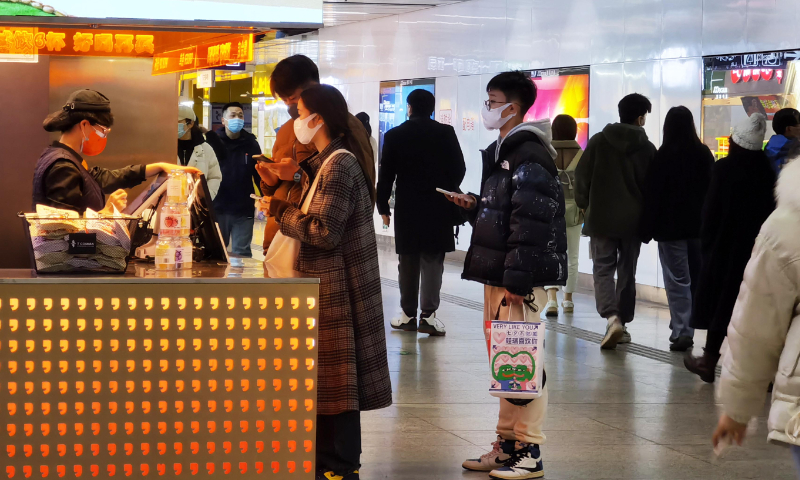
Residents go shopping at a shopping mall in Nanjing, East China's Jiangsu Province, on December 11, 2022. Consumption gradually resumed after the release of optimized COVID-19 response measures. Photo: VCG
Chinese local governments have moved to hand out consumption vouchers lately to stimulate domestic demand, as stores reopen amid the optimization of COVID-19 responses. Economists expect retail consumption will significantly rebound after the first quarter of 2023.
They suggest more consumption vouchers should be issued and other measures taken to increase people's incomes.
To elevate consumer confidence and release consumption potential, Shijiazhuang, capital of North China's Hebei Province, launched a shopping festival, during which city governmentissued consumption vouchers worth 101 million yuan ($14.5 million) for promotions, state broadcaster CCTV reported on Wednesday. According to the report, people could use the vouchers to buy cars, home appliances, jewelry and other items at the city's 3,000 local stores.
A dozen other provinces and municipalities have also stepped up issuance of coupons to stimulate consumption, especially after the Central Economic Work Conference.
For example, Shenzhen's Nanshan district is handing out consumption vouchers worth 200 million yuan, starting from December 18 and endingat the finish of the Chinese Lunar New Year, covering sectors including catering, automobiles and home appliances, according to local news outlet sznews.com.
Since the outbreak of COVID-19, all localities across China have issued consumption vouchers worth more than 16 billion yuan, mainly focused on pandemic-affected sectors including catering and accommodation, tourism, entertainment and sports, as well as consumption upgrading such as new energy vehicles (NEVs) and home appliances, according to media reports.
The intensifying efforts came as Chinese localities wereeyeing for a quick consumption sector recovery amid the optimization of COVID-19 controls and sprinting toward realizing their fourth-quarter goals.
Consumption has become a major driver of China's economy, contributing to over 60 percent of GDP in 2021. Affected by the pandemic and other factors, retail sales recorded a 5.9-percent year-on-year decline to 3.86 trillion yuan in November, data from the National Bureau of Statistics showed.
"The authorities may roll out more measures to propel consumption in 2023, including vouchers, to release domestic demand that has been restrained for three years," Yang Delong, chief economist at Shenzhen-based First Seafront Fund Management Co, told the Global Times on Wednesday.
He said China will experience a stable consumption recovery in two stages, with the pent-up spending to be released in the first half of the year. Morepeople may be willing to voluntarily spend along with the increase of incomes in the second half.
The annual Central Economic Work Conference held last week pointed to a focus on boosting domestic demand in 2023 by prioritizing the recovery and expansion of consumption, and increasing urban and rural incomes through multiple channels.
In this regard, the central government may extend policy stimulus next year and step up support in improving employment (especially jobs for youth and college graduates) as well as raising residents' incomes, according to UBS economists led byWangTao.
"Residential consumption in China is expected to significantly rebound, as the peak of the latest round of COVID-19 outbreakwill end in the first quarter of 2023," they wrote in a note sent to the Global Times.
UBS economists projected that the authorities will continue to adopt a proactive fiscal policy, saying that the national debt ratio may rise slightly to around 3 percent of GDP next year.
While China is striving to accelerate an economic recovery and realize high-quality growth amid mounting domestic and external challenges, the National Development and Reform Commission (NDRC), the top economic planner, recently released an action plan to boost domestic demand during the 14th Five-Year Plan period (2021-25).
The NDRC vowed to firmly adhere to the strategy, accelerate the cultivation of a sound domestic demand system, and create new demand through innovation-driven and high-quality supply, so as to achieve a high-level dynamic equilibrium between supply and demand. It plans to promote and accelerate the upgrading of consumption, boosting consumption in areas such as services and low-carbon products.
"Indeed, consumption vouchers have played an important role in driving domestic consumption over the past three years. More work should be done next year to increase residents' incomes to stimulate consumers' willingness to spend," Li Changan, a professor at the Academy of China Open Economy Studies of the International Business and Economics, told the Global Times on Wednesday.
He said that the income distribution structure needs further adjustment to improve low-income groups' income, and existing favorable policies on personal income tax should also be extended in 2023.




